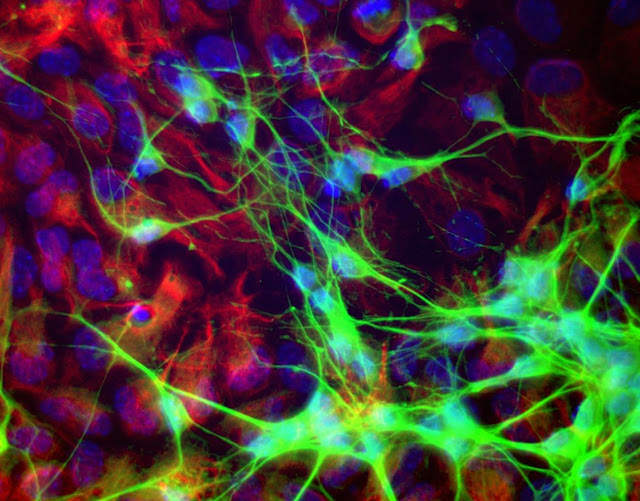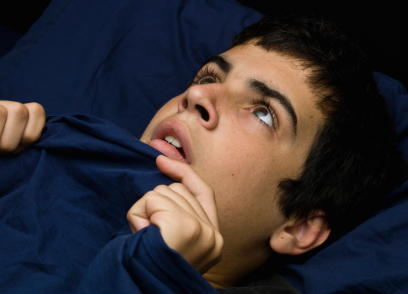Lavender Oil May Improve Anxiety
An oral preparation of lavender oil called Silexan decreased anxiety significantly more than placebo in a study by S. Kasper et al. published in the International Journal of Neuropsychopharmacology in 2014.
This randomized double-blind study of 539 patients with Generalized Anxiety Disorder compared two different doses of Silexan (160 mg and 80 mg) with a 20 mg dose of the antidepressant paroxetine and with placebo. Both doses of Silexan reduced anxiety significantly more than placebo did. While paroxetine performed better than placebo, that result did not reach statistical significance.
Sixty percent of the patients who received the 160 mg dose of Silexan showed reductions of 50% in scores on the Hamilton Anxiety Scale (HAMA). In addition to its anti-anxiety effects, Silexan was associated with an antidepressant effect, improved general mental health, and improvement in health-related quality of life.
Iron Deficiency Linked to Psychiatric Disorders in Children
Iron deficiency is the most prevalent nutritional deficiency in industrialized countries and can cause problems with cognitive and intellectual development. New research published in the journal BMC Psychiatry shows that it has psychiatric ramifications as well. Children and adolescents with iron deficiency anemia are at greater risk for psychiatric disorders, including depression, bipolar disorder, anxiety, and autism.
Iron supplementation should be implemented in children with iron deficiency anemia in order to prevent any possible psychiatric repercussions, and similarly, psychiatrists should check iron levels in young patients with psychiatric disorders.
Iron provides myelin for white matter in the brain and plays a role in the function of neurotransmitters.
Adversity May Increase Risk of Mood Disorders
In adults with bipolar disorder, adversity in childhood has been associated with an earlier onset of bipolar disorder compared to those who did not experience some form of adversity such as verbal abuse, physical abuse, sexual abuse, loss of a parent, abandonment, or neglect. At the 2013 meeting of the Society of Biological Psychiatry, Nancy Low et al. reported that the number of these stressful life events a child experienced was associated with the number of their anxiety symptoms, psychiatric disorders, and lifetime substance abuse. Having experienced 3 or more adversities was associated with a 3.5-fold increased risk for developing a mood disorder and a 3-fold increase in anxiety disorders and alcohol or drug abuse.
While the study has not yet been published in a peer-reviewed journal, the abstract (#194) may be found in the meeting supplement, Volume 73, Number 9S of the journal Biological Psychiatry.
Editor’s Note: Low’s study is the first to report that childhood adversity is a risk factor for the onset of bipolar disorder in the general population.
Given the increasing evidence for the persistence of epigenetic marks on DNA and histones (which can’t change the sequence of genes but can change their structure) in those who have experienced such stressors in childhood, this could provide a mechanism for the long-term vulnerability of these children to the development of mood disorders and a variety of physical illnesses.
Glial, Not Neuronal, Deficits May Cause Depression
The brain consists of 12 billion neurons and four times as many glial cells. Neurons conduct electrical activity, and it is thought that changes in neural activity and synaptic activity (where neurons meet) underlie most behaviors. It was once thought that glia were just fluff, but new research shows that they may play a role in depression.
There are three types of glia: astrocytes, oligodendrocytes, and mico-glia. Researcher Mounira Banasr had previously shown that neuronal lesions in the prefrontal cortex of mice did not produce depressive-like behaviors, but glial lesions did.
In a new study presented at a recent scientific meeting, Banasr reported that destroying astrocytes in the prefrontal cortex of mice induced depressive- and anxiety-like deficits. Using a virus that specifically targeted astrocytes, the researchers documented that the depressive behavior was specifically related to loss of astrocytes and not loss of other glial cell types, such as oligodendrocytes or micro-glia.
Editor’s Note: There is evidence of glial abnormalities in patients with mood disorders. Banasr’s research raises the possibility that glial deficits (rather than neuronal alterations) could be crucially involved in depression. In this study, the depressive- and anxiety-like behaviors persisted for 8 days following the astrocyte ablation, but by day 14 the animals had recovered, possibly with the production of a new supply of astrocytes. These data also raise the possibility that targeting the mechanisms of glial dysfunction could be a new avenue to pursue in the therapeutic approaches to depression.
Long-term Outcomes for Childhood-Onset Disorders: Anxiety Disorders
A symposium at the 2012 meeting of the American Academy of Child and Adolescent Psychiatry (AACAP) examined long-term outcomes of childhood onset disorders, including bipolar disorder, unipolar depression, ADHD, and anxiety disorder.
Course of Childhood Onset Anxiety Disorders
Danny Pine presented a study of 191 adolescents with an anxiety disorder, among whom 36% showed no anxiety disorder in adulthood, while 62% continued to have an anxiety disorder. Among a control population, 390 adolescents without an anxiety disorder remained so in adulthood, while 36 developed new onset of an anxiety disorder in adulthood. Sixty-two of the 98 participants who had anxiety disorders in adulthood had had the disorder continuously from its onset in adolescence. Thus, it appears that approximately two-thirds of adults with an anxiety disorder show a persistence of their childhood onset anxiety disorder, while approximately 1/3 had a new anxiety disorder diagnosis.
Editor’s Note: While all 4 of these major childhood onset psychiatric illnesses (bipolar, unipolar, ADHD, and anxiety disorders) show long term difficulties into adulthood in the majority of instances, it appears that the most severely impacted are those with bipolar disorder. These data are also consistent with retrospective data from multiple cohorts of adults with bipolar disorder, which indicate that those whose illness began in childhood fared more poorly in adulthood than those with adult-onset illness. Thus, while there has been a modicum of treatment research in childhood depression and anxiety disorder and a plethora of treatment studies in ADHD, the dearth of treatment studies in children with bipolar disorder is all the more disconcerting.
Bipolar disorder is common, occurring in some 2 to 3% of children and adolescents, and carries a relatively grave prognosis into adulthood in the majority of instances, especially when it is inadequately treated. Virtually all of the investigators in the area of childhood-onset bipolar who presented at the AACAP meeting have pleaded for increased treatment research for bipolar disorder in children, and one can only hope that their message is soon heard.
Anxiety and Depressive Disorders Often Precede the Onset of Bipolar Disorder in Those At High Risk Due to Family History
At the 2012 meeting of the American Academy of Child and Adolescent Psychiatry (AACAP) meeting, Anne Duffy and Gabrielle A. Carlson sponsored a symposium on the association between anxiety and minor mood disorders and subsequent bipolar disorder in those at high risk. Researchers presenting at the symposium consistently found that there is a sequence in which young people at high risk for bipolar disorder develop increasingly severe illnesses: first anxiety, then mood disorders, then bipolar illness.
One difference: the incidence of childhood-onset bipolar disorders in those at high risk because a parent has the disorder was lower in Canada, Switzerland, and the Netherlands than it was in the US.
Duffy, a professor of psychiatry in Calgary, noted that bipolar disorder is highly heritable even though most adults with bipolar illness do not have a family history of bipolar illness among their first-degree relatives. She shared estimates that if one parent has bipolar disorder their offspring have a 5% lifetime risk of developing bipolar disorder. If both parents have bipolar disorder their offspring have a 25% risk of developing bipolar disorder and a 35% incidence of developing any affective disorder (although other data by Lapalme et al. suggest it may be as high as 60%).
Duffy found that when parents responded well to lithium, their children tended to do the same. Lithium-responsive patients tended to be those without anxiety disorder and substance abuse and who had classic bipolar episodes and clear well intervals between episodes. Read more
Prenatal BPA Exposure Might Lead to More Hyperactivity, Depression, and Anxiety in Young Children
An article published by Braun et al. in Pediatrics last year suggests that children who were exposed to higher levels of BPA while in the womb exhibited more anxious and depressed behaviors and poorer emotional control and inhibition at age 3. Braun described the implications of this finding to Medscape Medical News:
“At this point, we don’t know what these findings mean in terms of clinical disorders of behavior,” Joe M. Braun, MSPH, PhD, from the Department of Environmental Health, Harvard School of Public Health, Boston, Massachusetts, told Medscape Medical News. “Future studies will need to determine if BPA exposures are associated with clinical behavior disorders,” he said.
BPA is used in a variety of consumer products, including dental sealants, food/beverage containers and linings, medical equipment, and thermal receipts, such as those from ATM machines. Virtually all people in industrialized nations are exposed to the plasticizer.
“People who are concerned about BPA exposure could decrease or eliminate their consumption of canned or packaged foods; they could also avoid contact with thermal receipts,” Dr. Braun said.
Among Bipolar Patients, Women Spend More Time Depressed Than Men Do
An article by Lori Altshuler et al. (including this editor Robert M. Post) published in the American Journal of Psychiatry in 2010 presents research that among bipolar patients studied over a period of 7 years, women spent more time than men depressed. Women had higher rates of rapid cycling and of anxiety disorders, both of which were associated to higher rates of depression.

Proportion of Time Spent Ill During Clinical Visits for Women and Men With Bipolar I or II Disorder (N=711)aaWomen and men, 35.6% compared with 28.7% of visits depressed; 50.4% compared with 56.9% of visits euthymic; 14.1% compared with 14.4% of visits hypomanic or manic.
Scopolamine Produces Larger Antidepressant and Antianxiety Effects in Women Than in Men
In a study published in Neuropscyhopharmacology, three sessions of intravenous scopolamine (4µg/kg over 15 minutes) led to rapid antidepressant response in both men and women, but the magnitude of response was larger in women. Women also experienced significant reduction in anxiety, as seen below:
Editor’s Note: Scopolamine is a potent blocker of acetylcholine receptors of the muscarinic type. This can cause side effects such as dry mouth and constipation. However, when given intravenously, scopolamine produces rapid onset of antidepressant effects in both bipolar and unipolar depressed patients. This study suggests that the drug may be even more effective in women.
Screening Tool for Depression and Anxiety Available via iPhone
My Mood Monitor, a website for mental health screening, has introduced depressioncheck, a free, mobile version of their M-3 Checklist, a scientifically validated screening tool for mood and anxiety disorders that can now be used via Apple’s iPhone and iPod Touch. It can be found in the Itunes App Store.
Adapted from the online version, the mobile version provides a short series of questions that measure indicators of mental health. Developed by a team of mental health practitioners and experts, the checklist takes only three minutes to complete. It is ideal to fill out in the waiting room prior to an appointment with a general practitioner so the doctor can be made aware of potential problems in the area of mental health. Depressioncheck is appropriate for those 18 years and older and its accuracy was confirmed in an article published in the Annals of Family Medicine in March 2010.
We recommend My Mood Monitor and the new mobile application as simple and reliable screening tools that can assess the presence of unipolar and bipolar mood and anxiety disorders, including obsessive-compulsive disorder, panic disorder, and PTSD. Read more










